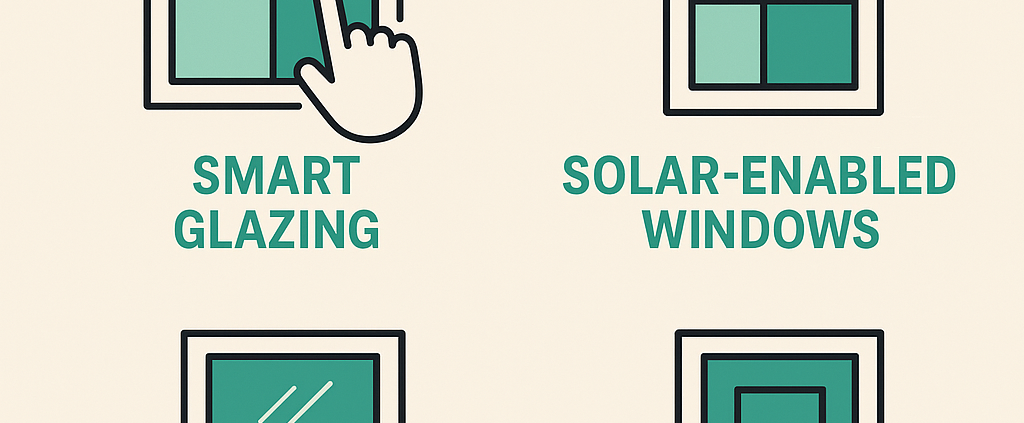The Future of Doors and Windows in the next 5 Years.
The Future of Doors and Windows: Sustainable Innovation for UK Homes & Businesses in the Next 5 Years
When we think of transforming our homes, doors and windows might not be the first things that come to mind. Yet, over the next five years, these everyday features are set to undergo a quiet revolution—one that could drastically reduce heat loss, cut energy bills, and help homeowners across the UK live more sustainably.
From smart glazing that adapts to the weather, to eco-friendly materials that lock in heat while cutting carbon emissions, the doors and windows of tomorrow won’t just be about style—they’ll be about performance, cost-effectiveness, and future-proofing our homes.
Smarter Materials, Greener Choices
One of the biggest shifts in the industry will be the materials used. Manufacturers are moving away from carbon-heavy production methods and looking at sustainable alternatives:
-
Quadruple glazing is already on the horizon, offering incredible insulation for UK homes and reducing heating bills in colder regions.
-
Transparent wood composites are being developed as a strong, eco-friendly alternative to glass, offering warmth and clarity without the same carbon footprint.
-
Bio-based insulation panels, made from waste paper, fibres, or even food by-products, are emerging as greener options for frames and cores.
Closer to home, many UK companies are already recycling aluminium, vinyl, and timber waste, while some are operating near zero-waste manufacturing plants powered by renewables.
Glass That Thinks for Itself
One of the most exciting developments is smart glazing. Imagine a window that automatically darkens on a hot summer’s day to keep your living room cool—or clears in winter to maximise sunlight and warmth.
-
Electrochromic glass allows homeowners to control the tint of their windows at the touch of a button—or even through an app.
-
Thermochromic and photochromic glass adjust passively to temperature or sunlight without any power input, keeping rooms comfortable year-round.
-
The next generation of smart windows will do even more—integrating ventilation systems, sensors that monitor indoor air quality, and automatic adjustments that respond to the weather.
These aren’t just gimmicks. They could reduce the reliance on air conditioning and heating, directly cutting energy costs and carbon emissions for UK households.
Smarter Manufacturing: Technology at the Factory
How these products are made is just as important as how they perform. UK and European manufacturers are increasingly adopting Industry 4.0 practices—robotics, IoT (Internet of Things) sensors, and AI—to streamline production.
-
This means less waste, more precision, and the ability to create bespoke doors and windows at lower cost.
-
3D printing and generative design are starting to influence how frames and panes are shaped—ensuring maximum efficiency for both heat retention and natural light.
For homeowners, this should translate into higher-performing products at more competitive prices.
Energy-Producing Doors and Windows
What if your windows didn’t just keep the heat in—but also generated electricity? This is closer than you think.
-
Solar glass technology allows transparent photovoltaic panels to be integrated into windowpanes.
-
Even door panels are being explored as mini solar-generators, creating an additional source of renewable energy without changing the look of your home.
For households aiming to reduce reliance on the grid—or prepare for a future of electric vehicles and home batteries—this is a game changer.
Built to Last—and Heal Themselves
Durability is another factor driving innovation. New coatings and composites will help doors and windows resist weather damage, UV rays, and general wear and tear. Some emerging materials are even self-healing, repairing minor scratches and surface damage on their own.
The longer these products last, the less waste ends up in landfill—and the more money homeowners save on replacements.
What This Means for UK Homes
Over the next five years, the UK homeowner can expect doors and windows to:
-
Drastically cut heat loss, thanks to ultra-efficient glazing and insulated frames.
-
Reduce household bills, by lowering heating and cooling costs.
-
Shrink carbon footprints, through bio-based materials, circular production, and embedded renewable technologies.
-
Offer smarter living, with glass that adapts to our unpredictable British weather and integrates seamlessly into smart home systems.
-
Provide long-term value, as innovations in durability extend product lifespans.
Final Thoughts
The humble door or window is evolving into something much more powerful: a central player in the UK’s journey toward greener, smarter living. These aren’t futuristic concepts—they’re technologies already being tested, refined, and, in some cases, entering the market.
For homeowners, architects, and builders alike, the next five years promise exciting opportunities to not only improve comfort and cut costs, but to play an active role in building a more sustainable future—one pane at a time.





Leave a Reply
Want to join the discussion?Feel free to contribute!